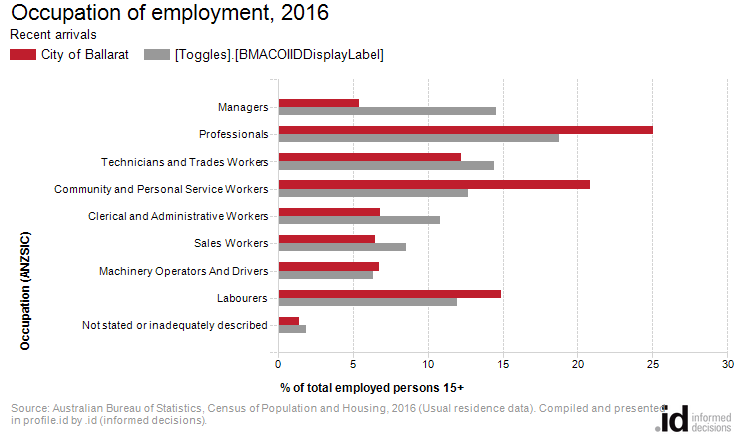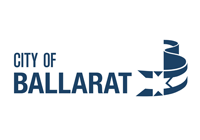City of Ballarat
Recent arrivals - Occupation of employment
In 2016, there were more recent overseas arrivals living in the City of Ballarat who worked as professionals than any other occupation.
The City of Ballarat's occupation statistics quantify the occupations in which recent arrivals (who are residents) work. The work destination may be in the local area or elsewhere.
The type of work done by recent arrivals is influenced by their age structure, qualifications and migration stream. Many of Australia's recent migrants are skilled arrivals who fill identified skill gaps in particular occupation groups.
Derived from the two Census questions:
'In the main job held last week, what was the person's occupation?' and 'What are the main tasks that the person himself/herself usually performs in that occupation?'
People born overseas, arriving between 2016 and 10 Aug 2021, employed in the week prior to Census and aged 15+
| Occupation of employment | |||||||
|---|---|---|---|---|---|---|---|
| City of Ballarat - Recent arrivals | 2016 | ||||||
| Occupation | Number | % | [Toggles].[BMACOIIDDisplayLabel] | ||||
| Managers | 80 | 5.4 | 14.5 | 15001 | |||
| Professionals | 369 | 25.0 | 18.8 | 15002 | |||
| Technicians and Trades Workers | 180 | 12.2 | 14.4 | 15003 | |||
| Community and Personal Service Workers | 307 | 20.8 | 12.7 | 15004 | |||
| Clerical and Administrative Workers | 101 | 6.9 | 10.9 | 15005 | |||
| Sales Workers | 96 | 6.5 | 8.5 | 15006 | |||
| Machinery Operators And Drivers | 100 | 6.8 | 6.3 | 15007 | |||
| Labourers | 220 | 14.9 | 12.0 | 15008 | |||
| Not stated or inadequately described | 21 | 1.4 | 1.9 | 15009 | |||
| Total employed persons aged 15+ | 1,474 | 100.0 | 100.0 | ||||
Source: Australian Bureau of Statistics, Census of Population and Housing (opens a new window) 2016 (Usual residence data). Compiled and presented in profile.id by .id (opens a new window)(informed decisions).

Dominant groups
An analysis of the jobs held by recent overseas arrivals in City of Ballarat in 2016 shows the three most popular occupations were:
- Professionals (369 persons or 25.0%)
- Community and Personal Service Workers (307 persons or 20.8%)
- Labourers (220 persons or 14.9%)
In combination these three occupations accounted for 896 people in total or 60.8% of the employed recent overseas arrivals.
In comparison, [Parameter].[BMACOIIDLabel] employed 18.8% in Professionals; 12.7% in Community and Personal Service Workers; and 12.0% in Labourers.
The major differences between the jobs held by the recent overseas arriving population of the City of Ballarat and [Parameter].[BMACOIIDLabel] were:
- A larger percentage of people employed as Community and Personal Service Workers (20.8% compared to 12.7%)
- A larger percentage of people employed as Professionals (25.0% compared to 18.8%)
- A smaller percentage of people employed as Managers (5.4% compared to 14.5%)
- A smaller percentage of people employed as Clerical and Administrative Workers (6.9% compared to 10.9%)
